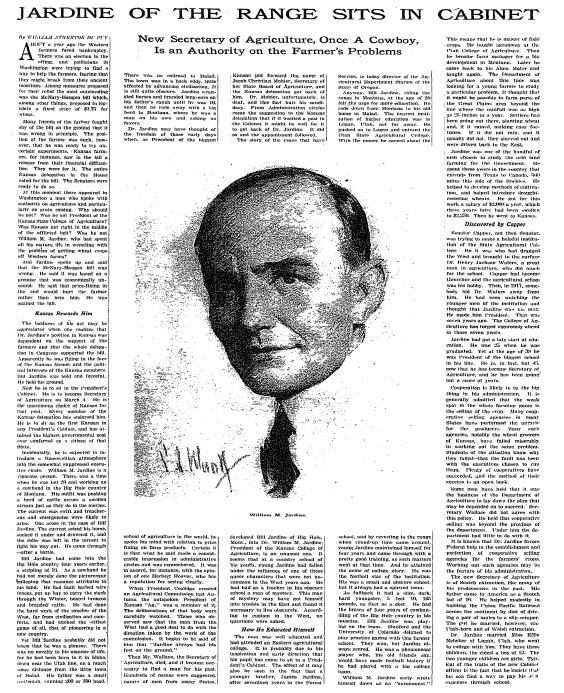Jardine of the Range Sits in Cabinet
A 1925 New York Times Magazine profile of new Agriculture Secretary William Jardine described him as a man of action, having grown up as a cowhand in the American West.
In November 1924, Agriculture Secretary Howard Mason Gore died while in office, at only age 58. A man named Howard Mason Gore filled in temporarily, for only about four months (after which he was elected governor of West Virginia). But President Calvin Coolidge nominated Jardine, president of Kansas State University, for the spot on a longer-term basis.
William Atherton wrote that Jardine didn't just work in academia, but had gotten his boots dirty in the real world:
There was a time when he was but 20 and working as a cowhand in the Big Hole country of Montana. His outfit was pushing a herd of cattle across a swollen stream, just as they do in the movies. The current was swift and treacherous and emergencies were likely to arise. One arose in the case of Bill Jardine. The current seized his horse, sucked it under and drowned it, and the rider was left in the torrent to fight his way out. He came through – after a battle.
...
As a cowhand, he had not merely done the picturesque galloping that romance attributes to his kind. He had built barbed wire fences, put up hay to carry the stock through the winter, busted broncos and branded cattle. He had done the hard work of the rancher of the West, far from civilization and comforts, and had bucked the stiffest game of all: that of pioneering in a new country.
Atherton wrote also wrote that Jardine was the first from his state:
He is to sit as the first Kansan in any president's Cabinet, and has attained the highest governmental post ever conferred on a citizen of that state.
Today, that's no longer true. One subsequent Agriculture Secretary hailed from Kansas: Dan Glickman, under President Bill Clinton. In American history, three other Cabinet members have hailed from Kansas:
Elizabeth Dole, President Ronald Reagan's Secretary of Transportation and later President George H.W. Bush's Secretary of Labor
Kathleen Sebelius, Obama's Secretary of Health and Human Services
Mike Pompeo, Trump's Secretary of State
No historical record appears to exist of Jardine's Senate confirmation vote, that I could find? He was apparently confirmed on February 17, 1925... but the Senate's Congressional Record for that day doesn't appear to list anything? Googling 'William Jardine Senate confirmation vote' brings up nothing.
ChatGPT, for what it's worth, says: "The specific vote tally for [Jardine's] confirmation is not readily available in historical records. His nomination, made by President Calvin Coolidge, was approved without significant controversy."
Today, the Agriculture Secretary is more controversial, this year for perhaps the first time ever.
The Senate's list of all Cabinet votes dating back to 1977 shows that all but one Agriculture Secretary nominee from 1977 through 2016 was either confirmed unanimously or by voice vote, a procedure used for relatively noncontroversial nominees. The only one who wasn't was President Ronald Reagan's second-term nominee Richard Lyng, who was confirmed in 1986 by... wait for it... 95-2.
As recently as 2009, President Barack Obama's nominee Tom Vilsack was confirmed by Senate voice vote. Then things start to change just slightly. In 2017, Trump's first pick Sonny Purdue was confirmed by (a still relatively wide) 87-11. Then in 2021, President Joe Biden nominated Vilsack again and he was confirmed by 92-7.
That pattern of bipartisanship held Until now. Brooke Rollins previously served as president and CEO of the America First Policy Institute, a Trump-aligned think tank. While Senate Republicans approved her unanimously, Senate Democrats largely opposed her by 19-28.
Someone please fact-check this in the comments section if I'm wrong, but I believe 28 dissenting votes in the Senate might be the most in American history for an Agriculture Secretary nominee?
Jardine of the Range Sits in Cabinet: New Secretary of Agriculture, Once A Cowboy, Is an Authority on the Farmer's Problems
Published: Sunday, March 1, 1925


